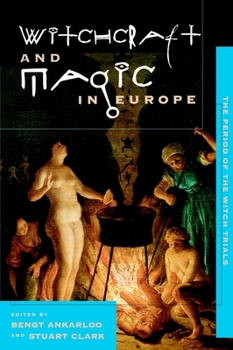Witchcraft and Magic in Europe, Volume 4: The Period of the Witch Trials
(Book #4 in the Witchcraft and Magic in Europe Series)
Select Format
Select Condition 
Book Overview
Each volume in the series Witchcraft and Magic in Europe combines the traditional approaches of political, legal, and social historians with a critical synthesis of cultural anthropology, historical psychology, and gender studies. The series, complete in six volumes, provides a modern, scholarly survey of the supernatural beliefs of Europeans from ancient times to the present day.
Most European prosecutions for the crime of witchcraft occurred between the fifteenth and seventeenth centuries, with the peak coming in the hundred years after 1560. This volume brings together the large amount of recent scholarship on witchcraft of this period and provides a novel analysis of the trials by considering the legal systems involved. Witch hunts, methods of torture, and the scientific interest in magic spells and demonology as an intellectual pursuit are also covered in detail.Format:Paperback
Language:English
ISBN:081221787X
ISBN13:9780812217872
Release Date:December 2002
Publisher:University of Pennsylvania Press
Length:224 Pages
Weight:0.75 lbs.
Dimensions:0.6" x 6.1" x 9.1"
Customer Reviews
3 ratings
Pretty Good overview book
Published by Thriftbooks.com User , 17 years ago
I really enjoyed this book. It was written by one of the top historians on the subject and it gives an overview of the witch trials in Europe and why they occurred. It is easy to read and informational.
Excellent scholarship.....
Published by Thriftbooks.com User , 22 years ago
THE PERIOD OF THE WITCH TRIALS is the 4th and last volume to be published in the six-volume series edited by Bengt Ankarloo and Stuart Clark `Witchcraft and Magic in Europe'. In some respects, I found this volume a small disappointment as it's thinner and less interesting than earlier volumes about `Biblical and Pagan' societies and `Ancient Greece and Rome' which relied heavily on archeological work. Still, the book contains first class scholarship and tells an important part of the total story. The volume includes several essays.Part 1. "Witch Trials in Continental Europe" investigates the secular record of the "trials" legal and otherwise that took place in Germany, France and the Mediterranean. William Monter suggests that since the 16th Century, many scholars have attempted to understand and explain the "witch burnings" which racked Europe in early modern times. He suggests while it is incredibly difficult to decipher the "mind of a different age" it is impossible not to link the burnings in the 16th Century with major developments of the age including the Reformation, counter-Reformation, and various political changes.Monter suggests a major criticism of Luther and Calvin regarding the church of Rome was that it tolerated "pagan" behavior. Early Christian theologians like Augustine linked the devil with witchcraft (from whom witches were thought to draw their power), but from the perspective of the reformers the church had not done an adequate job of acting on this information. The Catholic Church held that not believing in the devil was heresy and the church tried people for heresy--not witchcraft per se. Monter compares the relative moderation of the tribunals of the Mediterranean Inquisitions with the secular jurisprudence of central, southern and western Europe. He says that during this period "diabolical witchcraft" became a criminal offense meaning an activity involving secular government. People were tried for witchcraft by secular governments but seldom executed. Monter suggests most of the witch burning took place in villages where neither the secular government or the church had absolute control, and these villages (both Protestant and Catholic) tended to be East of the Rhine. Part 2. "Witch Trials in Northern Europe" covers the Netherlands, Scandinavia, UK, and Iceland. Expanding on Monter's essay, Ankarloo describes the judicial revolution that took place in the northern and western Europe. He suggests that during this period jurisprudence moved from an "accusatorial" to an "inquisitorial" position. The Humanist movement "enlightened" the judges who would not punish someone unless it could be shown that the accused had harmed another. Ankarloo also suggests that the notion that people burned for witchcraft were old crones is mistaken. At the early part of the witch burnings more men than women were executed and many of the victims of were children. In fact, the victims at Salem in the New World represent a good cross-secti
With an especial focus on the prosecutions
Published by Thriftbooks.com User , 22 years ago
Collaboratively compiled and edited by Bengt Ankarloo and Stuart Clark, Witchcraft And Magic In Europe: The Period Of The Witch Trials is a scholarly examination and analysis of supernatural beliefs in Europe with an especial focus on the prosecutions for the crime of witchcraft, which were most frequent during the fifteenth through seventeenth centuries. Examining witch hunts, methods of torture, historical incidents, and how beliefs in witchcraft, magic, and demonology affected European culture, Witchcraft And Magic In Europe is an informed and informative amalgamation of history and interpretation. Also very highly recommended are the University of Pennsylvania Press companion titles: Witchcraft And Magic In Europe: Biblical And Pagan Societies; Witchcraft And Magic In Europe: Ancient Greece And Rome; Witchcraft And Magic In Europe: The Middle Ages; Witchcraft And Magic In Europe: The Eighteenth And Nineteenth Centuries; and Witchcraft And Magic In Europe: The Twentieth Century.





